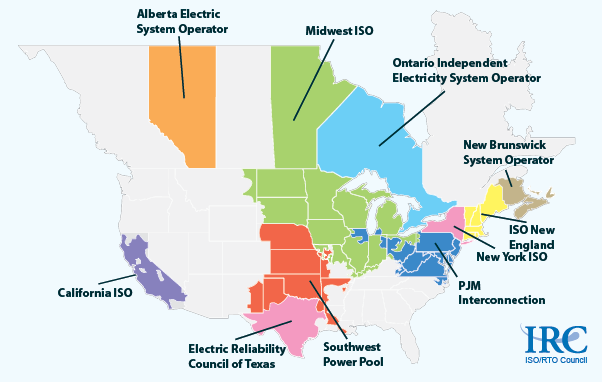Energy Markets
In the US, the energy markets started to be liberalized in 1992. Today, 16 states as well as DC are deregulated, contain various energy trading platforms, over-the-counter and wholesale trading, as well as retail energy markets, where customers can choose their energy supplier, and benefit from competitive offers.
| Summary |
|---|
Deregulated retail electricity and gas
Previously, in the United States, energy utility companies were monopolistic. This means that consumers could not choose where they got their electricity from. The price of electricity and gas was determined by the state's Public Service Commission. Today, many IPPs (Independent Power Producers) produce electricity competitively, and the price of electricity and gas are decided by the law of supply and demand (and not as previously by the state). This has created wholesale energy markets, as well as over-the-counter transactions. Also, many customers from the large NY utility companies can now purchase electricity and gas from various retail ESCOs (Energy Service Company), at a competitive price. To find out more about this, go to our Suppliers page. To find out more about the history of the energy markets deregulation, go to our page Introduction of competition on energy markets: reasons, and goals.
Wholesale electricity trading platforms
A wholesale market is where the IPPs (Independent power producers), other power generating companies, power traders, suppliers, large customers and other entities can buy or sell electricity publicly. Their activity can be monitored by the US Energy Regulatory Agency: FERC. There are several of these trading platforms in the US which are divided geographically, and managed by ISOs (Independent System Operators) or RTOs (Regional Transmission Organisations), which are independent, Federally regulated entities, responsible for the management and control of the electric transmission grid in a state or region. In North America they are:
- CAISO (California Independent System Operator)
- AESO (Alberta Electric System Operator)
- MISO (Midwest Independent System Operator)
- SPP (Southwest Power Pool)
- ERCOT (Electric Reliability Council of Texas)
- OIESO (Ontario Electric System Operator)
- NBSO (New Brunswick System Operator)
- ISONE (Independent System Operator of New England)
- NYISO (New York Independent System Operator)
- PJM Interconnection (Pennsylvania-New Jersey-Maryland Interconnection)
On a map, these entities are divided in such a manner:

To find out more about what a wholesale market is, and about the other wholesale markets in the US, visit our What is a wholesale electricity market?. To find out the difference between retail and wholesale electricity, read our What is the difference between wholesale and retail electricity? page.
Over the counter electricity trading
Over-the-counter (OTC) transactions are also a way for large power producers and energy traders to perform electricity transactions. An Over-the-Counter transaction is a private exchange of electricity for payment between two consenting parties. Like wholesale electricity transactions, they are also usually deregulated, but contrarily to wholesale electricity, OTC transactions are anonymous and are cannot be monitored by market authorities.
Electricity prices
Retail prices of electricity have globally increased over the past years.
This constant increase in the price of electricity is due to inflation.
For more information about the evolution of electricity prices, and for an explanation about inflation, please visit our page Evolution of the price of the kWh.